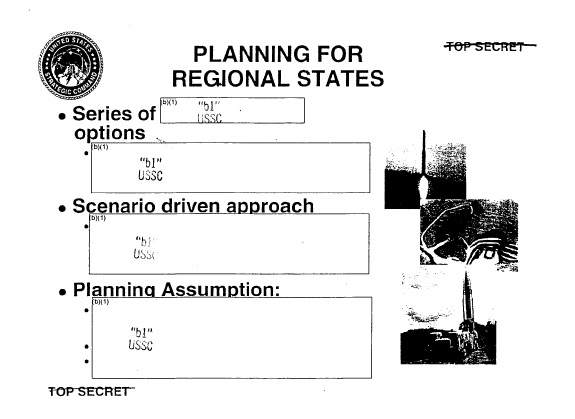Hans Kristensen has a great catch — a STRATCOM document redacted the names of certain countries now subject to strike planning, but left pictures of their weapons and facilities:
The 26-page declassified document, an excerpt from a 123-page STRATCOM briefing on the production of the 2003 strategic nuclear war plan known as OPLAN 8044 Revision 03, includes two slides that describe the planning against “regional states.” The first of these slides lists a “series of [deleted] options” directed against regional countries with weapons of mass destruction programs. The planning is “scenario driven,” according to the document. The majority of the document deals with targeting of Russia and China, but virtually all of those sections were withheld by the declassification officer.
The names of the “regional states” were also withheld, but three images used to illustrate the planning were released, and they leave little doubt who the regional states are: One of the images is the North Korean Taepo Dong 1 missile; another image shows the Libyan underground facility at Tarhuna; and the third image shows a SCUD B short-range ballistic missile.
I blogged about Tarhuna facility a while back after I found it in Google Earth. You may remember that there was some loose talk about using nuclear weapons against the facility, followed by denials. As far as I can tell, by the way, the IC was wrong about Tarhuna.
C’mon, folks. Redact the images next time.


I dont know if I would put too much stock in that. I’ve seen too many briefings where the person who prepared the brief picked images that looked cool but really didn’t have much to do with the text. For all anyone knows, the text could have been something like “Target underground facilities” with a random pic of Tarhuna or “concentrate on the third world missile threat” without specific refs to countries. After all, many countries use the Scud B.
From my experience with another country, I can testify that anonymous is right. More often than not, briefers want a slick presentation and choose whatever image is available.
As a general rule, Kristensen and others make way too much of sloppy drafting and briefing (the 2005 controversy on the US “Joint Nuclear Doctrine” draft revision testify to that).
The problem is that sloppiness should not be allowed in such sensitive matters, and that nuclear briefers and drafters should know that ANYTHING they write will be interpreted in ways they do not necessarily intend.